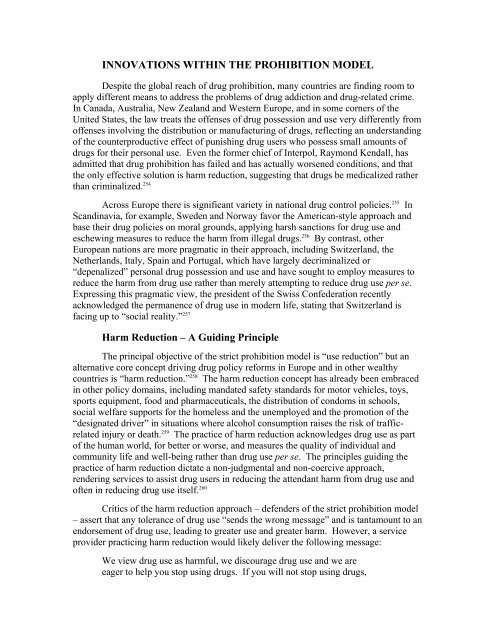Effective Drug Control: Toward A New Legal Framework
Effective Drug Control: Toward A New Legal Framework
Effective Drug Control: Toward A New Legal Framework
Create successful ePaper yourself
Turn your PDF publications into a flip-book with our unique Google optimized e-Paper software.
INNOVATIONS WITHIN THE PROHIBITION MODEL<br />
Despite the global reach of drug prohibition, many countries are finding room to<br />
apply different means to address the problems of drug addiction and drug-related crime.<br />
In Canada, Australia, <strong>New</strong> Zealand and Western Europe, and in some corners of the<br />
United States, the law treats the offenses of drug possession and use very differently from<br />
offenses involving the distribution or manufacturing of drugs, reflecting an understanding<br />
of the counterproductive effect of punishing drug users who possess small amounts of<br />
drugs for their personal use. Even the former chief of Interpol, Raymond Kendall, has<br />
admitted that drug prohibition has failed and has actually worsened conditions, and that<br />
the only effective solution is harm reduction, suggesting that drugs be medicalized rather<br />
than criminalized. 254<br />
Across Europe there is significant variety in national drug control policies. 255 In<br />
Scandinavia, for example, Sweden and Norway favor the American-style approach and<br />
base their drug policies on moral grounds, applying harsh sanctions for drug use and<br />
eschewing measures to reduce the harm from illegal drugs. 256 By contrast, other<br />
European nations are more pragmatic in their approach, including Switzerland, the<br />
Netherlands, Italy, Spain and Portugal, which have largely decriminalized or<br />
“depenalized” personal drug possession and use and have sought to employ measures to<br />
reduce the harm from drug use rather than merely attempting to reduce drug use per se.<br />
Expressing this pragmatic view, the president of the Swiss Confederation recently<br />
acknowledged the permanence of drug use in modern life, stating that Switzerland is<br />
facing up to “social reality.” 257<br />
Harm Reduction – A Guiding Principle<br />
The principal objective of the strict prohibition model is “use reduction” but an<br />
alternative core concept driving drug policy reforms in Europe and in other wealthy<br />
countries is “harm reduction.” 258 The harm reduction concept has already been embraced<br />
in other policy domains, including mandated safety standards for motor vehicles, toys,<br />
sports equipment, food and pharmaceuticals, the distribution of condoms in schools,<br />
social welfare supports for the homeless and the unemployed and the promotion of the<br />
“designated driver” in situations where alcohol consumption raises the risk of trafficrelated<br />
injury or death. 259 The practice of harm reduction acknowledges drug use as part<br />
of the human world, for better or worse, and measures the quality of individual and<br />
community life and well-being rather than drug use per se. The principles guiding the<br />
practice of harm reduction dictate a non-judgmental and non-coercive approach,<br />
rendering services to assist drug users in reducing the attendant harm from drug use and<br />
often in reducing drug use itself. 260<br />
Critics of the harm reduction approach – defenders of the strict prohibition model<br />
– assert that any tolerance of drug use “sends the wrong message” and is tantamount to an<br />
endorsement of drug use, leading to greater use and greater harm. However, a service<br />
provider practicing harm reduction would likely deliver the following message:<br />
We view drug use as harmful, we discourage drug use and we are<br />
eager to help you stop using drugs. If you will not stop using drugs,
















